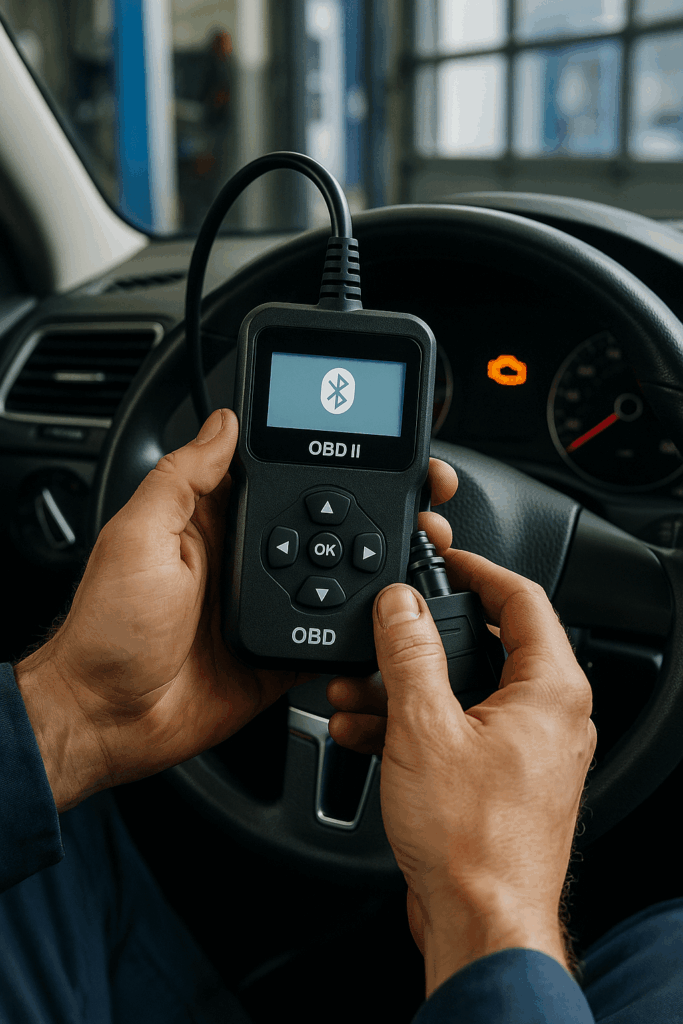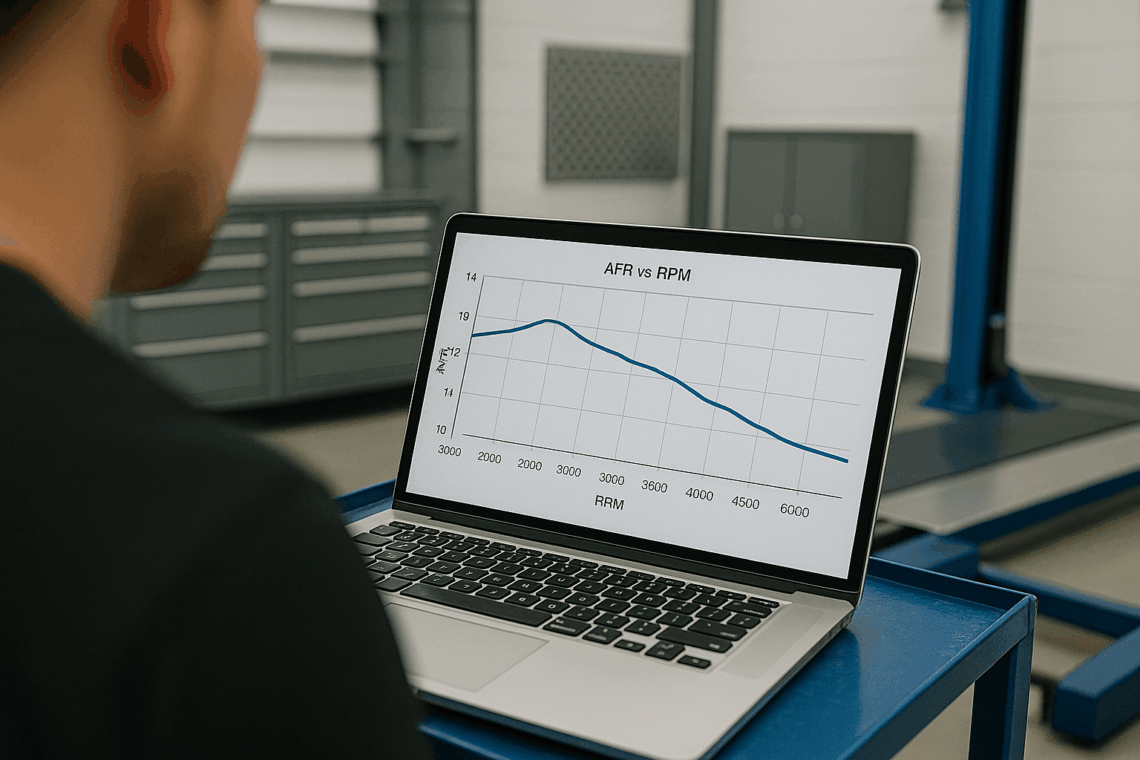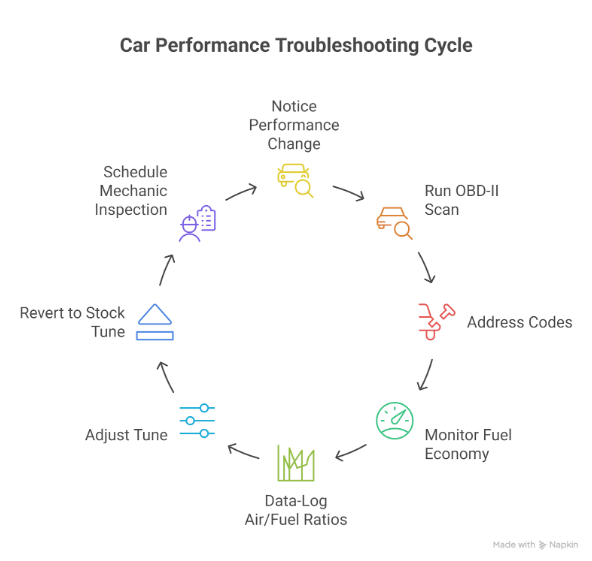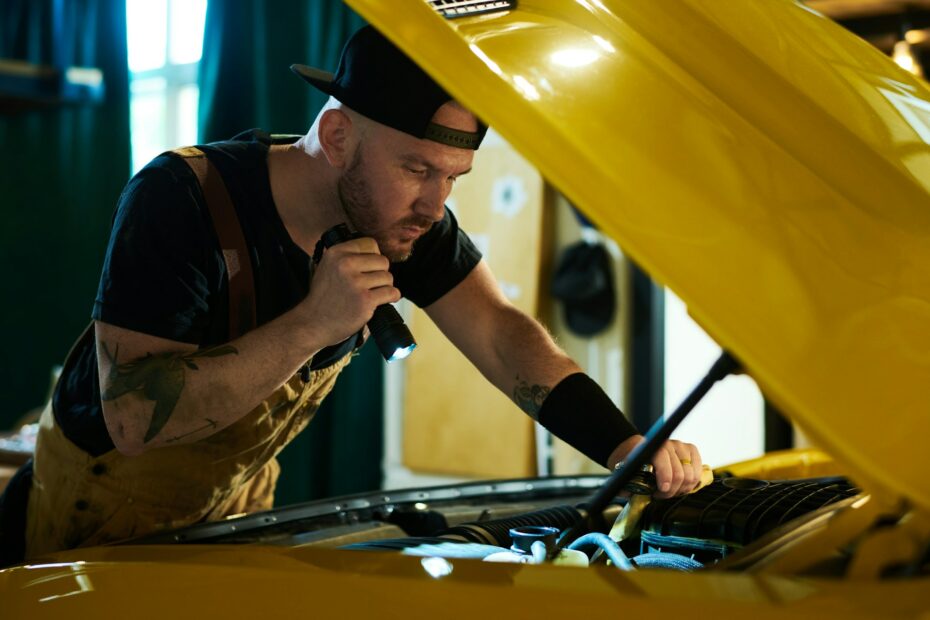Engine tuning problems can turn drivers’ dreams of more power into a costly nightmare. This guide provides a step-by-step roadmap to diagnose tune-related issues before they destroy your engine. Understanding bad tune symptoms early protects your warranty, saves thousands in repairs, and keeps you safe on the road.
Quick-Check Symptoms You Can Spot in 60 Seconds
⚠️ WARNING: These symptoms require immediate attention
- Fuel smell – Raw gasoline odor means your car isn’t burning fuel properly
- Sudden MPG drop – Fuel economy crashes of 10% or more signal serious tune issues
- New dashboard lights – Check engine, temperature, or oil pressure warnings
- Knocking sounds – Metallic pinging under acceleration indicates a dangerous detonation
- Rough engine behavior – Shaking, stalling, or hesitation that wasn’t there before
Core Engine Warning Signs
| Stock Performance | Bad Tune Symptoms | Risk Level |
| ⛽ 25-30 MPG city | ⛽ Below 20 MPG | 🔴 High |
| 🎯 Smooth idle (700-800 RPM) | ⚡ Rough/hunting idle | 🟡 Medium |
| 🌡️ EGT under 1200°F | 🔥 Over 1250°F exhaust temps | 🚨 Critical |
| 🚗 Normal acceleration | ⚠️ Hesitation, misfires | 🔴 High |
| 🔇 Quiet operation | 📢 Knocking, pinging sounds | 🚨 Critical |
Poor fuel economy ranks as the top indicator of tuning problems. When your car suddenly drinks fuel like a race car but delivers poor performance, it’s a good idea to check the tune parameters.
“How do I know if my tune is bad?” – symptom checklist
These warning signs indicate your tune requires immediate attention to prevent expensive engine damage.
🔍Fuel Efficiency Crash (<-10 % in a week)
- The car suddenly drinks enough fuel like a race car, but delivers poor performance
- Black exhaust smoke is visible during acceleration
- Strong smell of unburned gasoline around the car
- Injectors are working overtime to compensate for poor tuning
- The fuel system struggles to maintain proper air-to-fuel ratios
- The engine is consuming worse amounts of gasoline just to maintain basic operation
⚡Misfires, Stalls & Shakes
- Stuttering acceleration when one cylinder fails to fire
- Violent shaking that gets worse under load from multiple cylinder misfires
- Transmission shifts harder as it compensates for uneven power delivery
- Dramatic loss of power and fuel economy
- Frequent stalling, especially when the vehicle is under stress or climbing hills
- Hesitation during acceleration with unusual exhaust line sounds
🔥Overheating / Exhaust Temps >1 250 °F
- Aggressive ignition timing pushes exhaust temperatures beyond safe limits
- The cooling system works overtime to manage excessive heat
- Elements like the catalytic converter face dangerous thermal stress
- Sustained high temperatures damage internal engine parts
- Temperature gauge readings are consistently higher than normal operating speed
Dash & Diagnostics
Modern diagnostic tools give you direct access to your engine’s computer, revealing exactly what’s happening inside your car.
Step-by-Step Diagnostic Process:
- Connect the OBD-II scanner – Plug the scanner into the diagnostic port (usually under the dashboard near the driver’s left knee)
- Turn ignition to “ON” – The engine doesn’t need to run for basic code reading
- Scan for trouble codes – Record all active and pending codes before clearing anything
- Check live data streams – Monitor all the ratios, knock counts, and gasoline trim values in real-time
- Save diagnostic logs – Export data during different driving conditions (acceleration or highway speeds)
- Compare to baseline – Reference normal operating indicators for your specific vehicle
- Document findings – Keep records of code patterns and when they occur for your tuner

Check-Engine-Light Cheat Sheet (top five codes)
| Code | Description | Common Cause |
| P0300 | Random misfire | Lean gasoline mixture |
| P0171 | System too lean | Air leak |
| P0420 | Catalyst efficiency | Rich running condition |
| P0016 | Cam/crank correlation | Timing parameters off |
| P0131 | O2 sensor low voltage | Wrong air/fuel ratio |
Using a Bluetooth Scanner App Under $40
Modern OBD-II scanners connect to your smartphone and display real-time data. Monitor air/fuel ratios, knock counts, and gasoline trim values. Save data logs during different driving conditions – this information helps your tuner identify what’s happening under the hood.
Sound & Feel Clues
Your car communicates problems through sounds and vibrations that you can feel and hear during normal driving.
“What does a damaged engine sound like?” (PAA)
A healthy engine runs smoothly across all RPM ranges, but some tunes create distinct warning sounds:
- Knocking/pinging – Sounds like marbles rattling in a can, indicates detonation, damaging your pistons
- Excessive turbo whistle – Higher-pitched whining suggests boost pressure issues
- Rough exhaust note – Irregular popping or missing beats from cylinder misfires
- Metallic rattling – Internal engine elements stressed beyond design limits
- Grinding sounds – Transmission or clutch struggling with inconsistent power delivery
- Engine speed irregularities – RPM fluctuations during steady throttle input

Vibrations Under Load vs at Idle
Feel for changes in how your car behaves compared to normal operation:
- Rough idle – Smooth idle becomes shaky
- Acceleration hesitation – The engine stumbles where it used to pull strongly consistently
- Slow response – The engine takes longer to react to throttle inputs than normal
- Transmission confusion – Shifts at the wrong points due to inconsistent power delivery from the motor
- Steering wheel vibration – Engine misfires translate through the drivetrain to the steering wheel
- Seat/floor vibrations – Whole vehicle shakes from severe cylinder imbalances
Tune Stages Explained & Risk Profiles
| Stage 1 | Stage 2 | Stage 3 |
| +15-25% power | +30-50% power | +60%+ power |
| Minimal risk | Moderate risk | High risk |
| Stock components | Some upgrades needed | Major modifications |
| Warranty impact: Low | Warranty impact: Medium | Warranty impact: High |
“A Stage 1 tune with proper indicators rarely hurts your engine when done correctly. However, pushing beyond Stage 2 without supporting modifications is asking for trouble.” – Master Technician, ASE Certified
🛡️Does a Stage 1 tune hurt your engine? Generally, no, if performed by an experienced tuner using conservative parameters.
🔧What is Stage 2/3 tune? Stage 2 requires hardware upgrades like exhaust and intake modifications. Stage 3 involves internal engine components and fuel system changes.
Smart ECU Backup & Version Control Before Tuning
💡 Treat your ECU like valuable software
Creating a complete ECU backup is an absolute must before any tuning work. Professional tuners use tools that read and save your original calibration, but many DIY guides skip this critical step. Here’s the smart approach:
- Full stock backup – Save every indicator, not just fuel and ignition tables
- File naming system – Use format: “YYYY-MM-DD_ModList_OctaneRating”
- Checksum verification – Compare hash values to ensure clean backups
- Version tracking – Keep logs of what changed between tune revisions
- Roll-back testing – Verify you can return to previous versions
Flash counters in modern ECUs track programming cycles. Some elements limit total flashes, making backup files even more valuable. Store multiple copies and include notes about what modifications were active for each tune version.
Troubleshooting Flowchart – from Symptom to Fix

Systematic diagnosis prevents wasted time and money when tune problems develop. A good idea is to work through symptoms methodically rather than jumping to expensive solutions – many issues that seem complex actually require simple fixes. If your troubleshooting process feels slow, that’s normal for proper diagnosis.
Sometimes you’ll need to replace components, but often the problem lies in tuning parameters rather than hardware failure. An experienced mechanic can help distinguish between tune-related issues and mechanical problems that require actual repair work.
When to Call a Pro & Expected Costs
| Service | Price Range | When You Need It |
| Diagnostic scan | $100-200 | First sign of problems |
| Re-tune session | $300-600 | Multiple symptoms present |
| Dyno tuning | $500-1200 | Custom modifications |
| Engine rebuild | $3000-8000 | Internal damage confirmed |
“Most customers wait too long to address tune problems. Early intervention costs hundreds, not thousands.”
Insurance typically won’t cover tune-related damage. Some warranty companies specifically exclude modified cars. Factor these costs into your modification budget from the first time you consider tuning.
Preventive Tips to Avoid a Bad Tune Next Time
✅ BEST PRACTICES
🔍 Research your tuner – Check reviews, certifications, and customer examples
📊 Verify tune maps – Ask for before/after data logs and dyno charts
📱 Post-tune monitoring – Data-log for 500 miles after any changes
🛠️ Maintenance schedule – Keep oil changes and all filters current
⛽ Quality fuel – Use recommended octane rating consistently
🔧 Component inspection – Check spark plugs, coils every 15,000 miles
📈 System monitoring – Watch economy, temperatures, performance trends
Quality tuners provide detailed documentation and stand behind their work. They’ll explain what parameters changed and why. Be wary of tuners who won’t share technical details or promise unrealistic power gains.
Consider visiting EpicVIN to find out what other technical aspects require attention and how to address them correctly.
FAQ
Can a bad tune cause engine damage?
Yes, incorrect ignition timing and fuel parameters can destroy car pistons, valves, and catalytic converters.
How do I know if my tune is bad?
Watch for poor economy, rough idle, stalling, or new engine noises that weren’t there before.
Does a Stage 1 tune hurt your engine?
Conservative Stage 1 tunes rarely cause car engine damage when performed by experienced professionals.
Will reverting to stock ECU settings fix the damage?
Stock settings stop further damage but won’t repair existing mechanical problems.
Why did my catalytic converter fail after tuning?
Rich gasoline mixtures from poor tuning parameters overheat and damage catalyst materials.
Can bad tunes void a factory warranty?
Yes, car manufacturers can deny warranty claims for tune-related damage.
Is remote (email) tuning as safe as dyno tuning?
Remote tuning works well for experienced tuners with proper data logging feedback.
How often should I datalog after a new tune?
Log during different driving conditions for the first 500 miles, then monthly checks.
